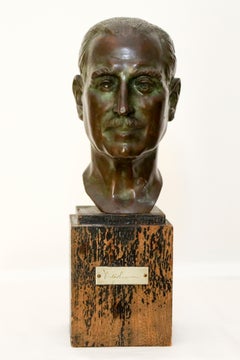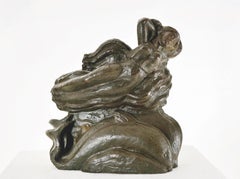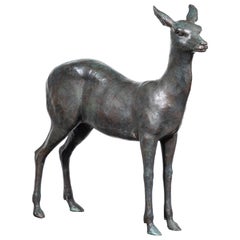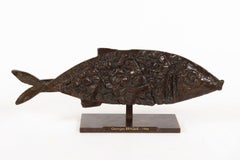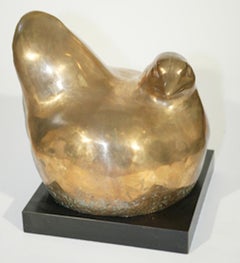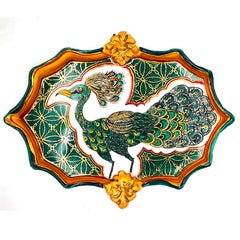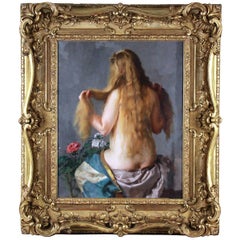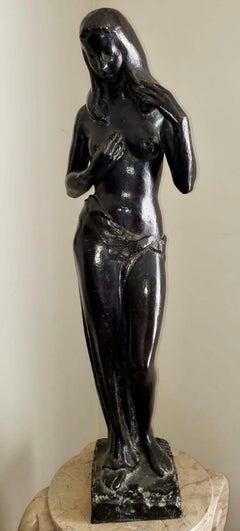1940s Art
Period: 1940s
Color: Gold
Bronze Bust of a Gentleman by Nison Tregor
Located in Brookville, NY
Nison Tregor
Born in Lithuania of Polish parents, Nison Tregor studied sculpture at the Warsaw Academy of Fine Arts. After immigrating to the United State...
Category
American Realist 1940s Art
Materials
Bronze
Maqueta las toninas
Located in Miami, FL
Maqueta las Toninas, 1944
BMY-022, 1970
Edition 1/25
Bronze
22 x 22 x 10 cm
8.6 x 8.6 x 3.9 in
ABOUT THE ARTIST
Narvaez was born in Porlamar, Venezuela, in 1905; he was the fifth son of eleven siblings; his parents were Jose Lorenzo Narvaez and Vicenta Rivera. Don José Lorenzo, a multifaceted and creative man, sowed the seed of creativity in his son. “My father did not fit in with his fantasies of cabinetmaker, bricklayer, master builder, and self-taught architect.”1 From an early age, Francis was led to the artistic activity, he traced, carved, made replicas of the furniture and the saints restored by his father.
In 1920 he obtained his first professional assignment, a San Rafael for the Church of Carupano, and, in 1922, his father authorized him to travel to Caracas to pursue his studies as an artist. He studied at the atelier of Marcos Castillo, at of the Angel Cabre y Magriña and at the Academy of Fine Arts in Caracas, where he was introduced to the painters and intellectuals of the time.
In 1928 he presented his first solo exhibition at the Club Venezuela. With the money raised from the sale of the works and the support of Monsignor Sosa, and the Ministers Centeno Grau and Arcaya, he studied in Paris on a scholarship. Once there, he enrolled at the Académie Julian, where Tito Salas, Cristóbal Rojas and Arturo Michelena had also studied. It was in Paris where, unable to work in wood, he turned to stone carving. “In Paris, I didn’t have wood, so I carved a lot in stone (…), when there were demolitions I purchased chunks of stone, I would take them to the workshop and carve them.”2
His first attempts at volumetric sculptures and painting in plain colours, linked to the thematic of American miscegenation and Creole reality, can be traced back to that first trip to Paris. During his stay in the French city, Arturo Uslar Pietri, Alfredo Boulton, and Finita Vallenilla supported the artist both financially and logistically, and in February of 1930, the trio of friends arranged another exhibition for him at the Club Venezuela. Narvaez describes his exhibition as follows: “(…) in it I feel that the sculptural work is more my own, done with more assurance, a response to my pursuit of large planes, stylisation and synthesis.”3 By then, as Boulton himself noted in his book about the artist, Narvaez departed from most of the artistic traditions that prevailed by that time in Venezuela.
In 1931 he returned to Caracas and established his atelier at the Barrio Obrero in Catia. The atelier became the hub of the intellectual life of the time. “In those years, the atelier of Francisco Narvaez was the hub of the greatest Venezuelan hope. Nothing comparable to it can be found either before or since.”4
From that year onwards, exhibitions, projects, trips, and awards we multiplied. He was awarded the President of the Republic of Venezuela Prize, the National Sculpture Prize of the 1st Official Venezuelan Art Salon, and the John Boulton Prize of the 3rd Annual Venezuelan Art Salon; for the Military Academy, he produced a spectacular relief entitled La Patria.
In 1945, commissioned by the architect Carlos Raúl Villanueva, he produced two groups of sculptures known as Las Toninas, both located in the O’Leary Square. There, as he himself states, he incorporates some baroque patterns into the figures to the source itself: “It is a work of balance between the decorative requirements and the sculpture of planes and angles.”5
In 1948 he was awarded the National Painting Prize. In the same year, he was called upon by the architect Carlos Raul Villanueva to participate in the project for the arts integration in the Universidad Central de Venezuela. Francisco Narvaez’s public output continued with works such as the statue of Fermín Toro, La Educacion, La Ciencia, three murals (produced by María Luisa Tovar) for the Instituto de Medicina Experimental, El Cristo; el Atleta, the equestrian statue of General Rafael Urdaneta.
In 1953 he was appointed Director of the School of Plastic and Applied Arts, and in July of the same year, he exhibited “Francisco Narvaez, Maderas, Piedras y Bronces” (Francisco Narvaez, Woods, Stones and Bronzes) at the Museum of Fine Arts.
Narvaez is, unquestionably, one of the great Venezuelan sculptors, his work goes through various stages and interests; as the art world evolves, the artist does not remain in his initial scopes of work. His creations are not imposed by the prevailing trends or fashion but do evolve by experimenting with new materials and interests.
When one peruses the artist’s lengthy list of exhibitions, commissions, and awards, it is worth remembering the Narvaez who embark on his career as a child and who, overcoming obstacles, knew how to make the most of his curiosity. He did not settle for living off his successes. He did not remain stagnant as many creators of his environment did. Narvaez managed to understand the changes in the history of art around him. We must not overlook the fact that Francisco Narvaez is an artist amid all the changes occurring in the art world. He moves from the classics to the great transformations in the art world. It is the Europe of Picasso, Braque, Arp. He observes, he is aware of what is happening in the centres of the world of art, but between his craft and his sensitivity, the result is NARVAEZ, his stamp, and his identity.
Francisco Narvaez comes from tradition, and his first stage is linked to the classics, to the exploration of his heritage, but always with his very own language. Throughout his prolific career, he knew how to remain true to himself, without disregarding the influences of his surroundings or his artistic interests: his ability as a sculptor, his selection of materials, whether they were wood, stone or bronze; his choice of the subject of his work…His mastery and great craftsmanship are a constant that over time have made him a leading player in the history of contemporary Venezuelan and world art.
From his beginnings, no subject was foreign to him. His paintings, drawings, aquarelles, and sketches are testimony to his prolific output. Among his themes are portraits, our traditions, still lifes, and landscapes. Narvaez is an artist who represents his time. Later, he evolved towards purer and simpler forms, abandoning figurative art for short periods.
In 1956 he declared to the newspaper El Nacional: “Every day I am freeing myself, it is a soul that frees itself from the ephemeral wrappings of the circumstantial always, as well as from the inevitable weight of the anecdote. This second stage of my work is remarkably close to abstractionism, even if there are still certain figures or figurations in the sculptures that I will shortly be showing. However, pure, and absolute abstractionism, it will treat the form itself as the sole reason for its existence on the plane of artistic excellence.”6
The artistic development was his professional life. Each period of his life as an artist, he went one step further, searching, solving, seeing plenty of things and understanding how diverse expressions were transforming themselves. His hands followed his gaze and his mind, always inquisitive. He added movement to the volumes.
Arturo Uslar Pietri, “Formas Nuevas”, Cromotip editions, 1956 “Francisco Narvaez is a path: the path that Venezuelan sculpture...
Category
Baroque 1940s Art
Materials
Bronze
Large, Cast Bronze Doe
Located in Newport Beach, CA
Substantial, sensitively molded, graceful circa 1940, hand-cast, bronze sculpture of a doe.
Category
1940s Art
Materials
Bronze
Bronze "Eingekauertes Rind II", 1947 by Ewald Mataré
Located in Berlin, DE
Bronze with light gold patina, 1947. Hand signed by the artist. One of seven casts.
Very good condition
Dimensions: Height 3.35 in ( 8,5 cm ), Width 4.92 in ( 12,5 cm ), Depth 1.97 ...
Category
1940s Art
Materials
Bronze
Poisson, Georges Braque, Fish, Sculpture, Bronze, 1940's, Postwar, Valsuani
Located in Geneva, CH
Poisson, Georges Braque, Fish, Sculpture, Bronze, 1940's, Postwar, Valsuani
Ed. 6/6 pcs
Signed and numbered underneath : 6/6, cire perdue, C.Valsuani fondeur.
Certificate of authent...
Category
Post-War 1940s Art
Materials
Bronze
Hen, Gilded Hen in Polished Bronze
Located in Brookville, NY
This Sculpture "Hen" by William Zorach in polished bronze is numbered 3/6 although according to the artist son, only 4 were ever cast. Executed in 1946, signed on the reverse and nu...
Category
American Modern 1940s Art
Materials
Bronze
Early Murano Glass Free Form Abstract Blown, Cut, Glass Sculpture in Bronze Vase
Located in Surfside, FL
This piece appears unsigned and unmarked. It came from an important estate in the Palm Beach area.
It is an abstract flame or torch in a bronze vase.
Venetian glass (Italian: vetro ...
Category
Abstract 1940s Art
Materials
Bronze
Käthe Kollwitz Bronze Sculpture "Der Abschied" ( Leave )
Located in Berlin, DE
Very emotional sculpture by Käthe Kollwitz ( 1867-1945 ), Germany. Conceived 1940/1941. Bronze dark patinated on granite rectangular base. One of a 50 pieces, cast 1975. Signed down...
Category
Expressionist 1940s Art
Materials
Granite, Bronze
Passo di Danza - Bronze Sculpture by Giuseppe Mazzullo - 1946
Located in Roma, IT
Bronze sculpture with wooden base. Signed and dated under the base.
Certificate of authenticity signed by the artist,
Category
Modern 1940s Art
Materials
Bronze
Owl III, Patinated Bronze Sculpture by Antonovici
Located in Long Island City, NY
Antonovici was born in Neamt, Romania on February 18, 1911, and graduated from the Fine Arts Academy in Iasi, Romania, in 1939. In 1940, Antonovici studied in Zagreb with the famous Croatian sculptor Ivan Mestrovici, until his arrest by Italian fascists...
Category
Modern 1940s Art
Materials
Bronze
Sleeping Owl, Bronze Sculpture by Antonovici - Brancusi's Protege
Located in Long Island City, NY
Artist: Constantin Antonovici, Romanian (1911 - 2002)
Title: Sleeping Owl
Year: 1947
Medium: Bronze with Patina on Marble Base, signature and number inscribed
Edition: 1/9
Size: 29 i...
Category
Modern 1940s Art
Materials
Marble, Bronze
Seagull Lamp
Located in Missouri, MO
William F. Boogar, Jr.
Seagull Lamp 1946
Bronze
approx. 15 1/4" High x 6 1/2" Wide
Signed and Dated Bottom
WILLIAM F. BOOGAR, Jr., the Provincetown sculp...
Category
Modern 1940s Art
Materials
Bronze
Exceptional set of complete works, dedicated, with 8 original endpage drawings
By Jean Cocteau
Located in Collonge Bellerive, Geneve, CH
Jean Cocteau
Exceptional copy of the complete works in 9 volumes, dedicated to Jacques Fonson, 8 with original endpage drawings
Half bound in red morocco with gold lettering
8 volum...
Category
Surrealist 1940s Art
Materials
Gold Leaf
Related Items
Roman 18th century terracotta model for the sculpture of San Camillo de Lellis
Located in London, GB
This remarkably fluid terracotta bozetto was made in preparation for Pietro Pacilli’s most important public commission, a large-scale marble statue of San Camillo de Lellis for the nave of St Peter’s Basilica in Rome. Expressively modelled, this terracotta sculpture is a rare and significant work made by a major Roman sculptor at a transformative moment of European sculpture. Pacilli began his working life on the great Baroque decorative projects initiated in the seventeenth century, but he found success as a restorer of ancient sculpture working to finish antiquities for a tourist market, becoming an important figure in the emergence of an archaeologically minded Neoclassicism. Pacilli trained Vincenzo Pacetti and provided important decorative work for the Museo Pio-Clementino, at the same time he is recorded restoring some of the most celebrated antiquities excavated and exported during the period.
Pacilli was born into a family of Roman craftsmen, his father Carlo was a wood carver, and Pacilli is recorded working with him on the Corsini Chapel in San Giovanni Laternao as early as 1735. In 1738 his terracotta model of Joseph and Potiphar’s Wife won the first prize in the second class of the sculpture concorso at the Accademia di San Luca, this is particularly notable as Bartolomeo Cavaceppi came third. He worked as a carver and stuccoist completing works for the churches of San Marco and SS. Trinita dei Domeniciani Spagnoli. Pacilli operated as a sculptor and restorer of antiquities from his studio at the top of the Spanish Steps, close to Santa Trinita dei Monti, where he is listed as a potential vendor to the Museo Pio-Clementino in 1770.
In 1763 Pacilli completed a silver figure of San Venanzio for the treasury of San Venanzio. He is recorded as Pacetti’s first master and it was evidently through Pacilli that he began to acquire his facility as a restorer of ancient sculpture. Pacilli, at his studio ‘poco prima dell’Arco della Regina alla Trinita dei Monti,’ exercised, what the nineteenth-century scholar, Adolf Michaelis called ‘rejuvenating arts’ on several important pieces of classical sculpture, including in 1760 the group of a Satyr with a Flute for the natural brother of George III, General Wallmoden, Hanovarian minister at Vienna. In 1765, Dallaway and Michaelis record that Pacilli was responsible for the restorations, including the addition of a new head, to the Barberini Venus which he had acquired from Gavin Hamilton. The Venus was then sold to Thomas Jenkins, who in turn passed it on to William Weddell at Newby Hall. In 1767 Pacilli exported a series of ancient busts ‘al naturale’ including portraits of Antinous, Julius Ceaser and Marus Aurelius, also a statue of a Muse and a Venus. As early as 1756 Pacilli seems to have been operating as an antiquarian, helping to disperse the collection of the Villa Borrioni. Pacilli supplied sculpture to notable British collectors, including Charles Townley, who on his first trip to Italy purchased the Palazzo Giustiniani statue of Hecate from Pacilli. Pacilli was involved with the Museo Pio Clementino from its conception, supplying busts of Julius Ceaser and a Roman Woman as well as completing stucco putti surmounting the arms of Pope Bendedict XIV to signal the entrance to the new Museo Critiano.
In 1750 Il Diario Ordinario del Chracas announced that Pacilli had begun work on a sculpture of San Camillo de Lellis for St Peter’s. Camillo de Lellis founded his congregation, the Camillians, with their distinctive red felt crosses stitched on black habits in 1591. Having served as a soldier in the Venetian army, Camillo de Lellis became a novitiate of the Capuchin friars, he moved to Rome and established a religious community for the purpose of caring for the sick. In 1586 Pope Sixtus V formerly recognised the Camillians and assigned them to the Church of Santa Maria Maddalena in Rome. Camillo de Lellis died in 1614 and was entombed at Santa Maria Maddalena, he was canonised by Benedict XIV on June 26, 1746. It was an occasion that prompted the Camillians to make a number of significant artistic commissions, including two canvases by Pierre Subleyras showing episodes from San Camillo’s life which they presented to Benedict XIV. In 1750 Pacilli was commissioned to fill one of the large niches on the north wall of the nave with a sculpture of San Camillo.
The present terracotta bozetto presumably had two important functions, to enable Pacilli to work out his ideas for the finished sculpture and at the same time to show his design to the various commissioning bodies. In this case it would have been Cardinal Alessandro Albani and Monsignor Giovan Francesco Olivieri, the ‘economo’ or treasurer of the fabric of St Peter’s. Previously unrecorded, this terracotta relates to a smaller, less finished model which has recently been identified as being Pacilli’s first idea for his statue of San Camillo. Preserved in Palazzo Venezia, in Rome, the terracotta shows San Camillo with his left hand clutching his vestments to his breast; the pose and action more deliberate and contained than the finished sculpture. In producing the present terracotta Pacilli has expanded and energised the figure. San Camillo is shown with his left hand extended, his head turned to the right, apparently in an attempt to look east down the nave of St Peter’s. The model shows Pacilli experimenting with San Camillo’s costume; prominently on his breast is the red cross of his order, whilst a sense of animation is injected into the figure through the billowing cloak which is pulled across the saint’s projecting right leg. The power of the restrained, axial contrapposto of bent right leg and outstretched left arm, is diminished in the final sculpture where a baroque fussiness is introduced to the drapery. What Pacilli’s terracotta demonstrates, is that he conceived the figure of San Camillo very much in line with the immediate tradition of depicting single figures in St Peter’s; the rhetorical gesture of dynamic saint, arm outstretched, book in hand, head pointed upwards was perhaps borrowed from Camillo Rusconi’s 1733 sculpture of St. Ignatius...
Category
Baroque 1940s Art
Materials
Terracotta
Vintage Peacock I (Wall Piece/Dish) (MADE TO ORDER) (~50% OFF LIMITED TIME ONLY)
Located in Kansas City, MO
(MADE TO ORDER) (Hand-painted, hand-made, porcelain)
*Lead Time may vary between 1-3 weeks
Melanie Sherman
Vintage Peacock I (Wall Piece/Dish (handpainted)
Porcelain, Glaze, Overglaze, Chinapaints, 24k German Gold Luster, Brass Wire (for hanging, can be removed)
Year: 2022
Size: 4.5x6x0.5in
Signed by hand
COA provided
Ref.: 924802-1330
------------------------
My ceramics are handmade and painted with the finest overglazes from Europe. The gold luster used is 24k liquid Gold from Germany. Every piece is unique. My imagery is inspired by vintage Meissen dinnerware...
Category
Baroque 1940s Art
Materials
Brass
Arrowhead
By Herb Alpert
Located in Palm Desert, CA
A sculpture by Herb Alpert. "Arrowhead" is a bronze, abstract, totem sculpture by contemporary artist Herb Alpert.
Category
Contemporary 1940s Art
Materials
Bronze
Vintage Peacock III (Wall Piece/Dish (hand-painted, made to order by the artist)
Located in Kansas City, MO
Melanie Sherman
Vintage Peacock III (Wall Piece/Dish (handpainted)
Porcelain, Glaze, Overglaze, Chinapaints, 24k German Gold Luster, Brass Wire (for hanging, can be removed)
Year: 20...
Category
Baroque 1940s Art
Materials
Brass
Monumental Outdoor Bronze sculpture "Sfera Antares" by Gianfranco Meggiato
Located in Palm Beach, FL
Beautiful kinetic out-door sculpture by Gianfranco Meggiato. Bronze.
Gianfranco Meggiato was born on August 26, 1963 in Venice, where he studied stone, bronze, wood and ceramics scu...
Category
Abstract 1940s Art
Materials
Bronze
H 78.75 in W 47.25 in D 47.25 in
Untitled
By Bill Nebeker
Located in Palm Desert, CA
"Untitled" is a bronze sculpture by Bill Nebeker. Signed on reverse base "Bill Nebeker CA 6/30". The full size is 23 1/2 x 18 1/4 x 8 1/2 inches.
Bill Nebeker is an American artist ...
Category
American Realist 1940s Art
Materials
Bronze
The Gardener with Sunflower
Located in Belfast, GB
Patrick O'Reilly
The Gardener with Sunflower
Bronze
47 1/4 x 49 1/4 x 15 3/4 in
120 x 125 x 40 cm
This piece is entitled The Gardener with Sunflower. It is a large scale outdoor scu...
Category
Contemporary 1940s Art
Materials
Bronze
Mid Century Bronze Sculpture -- Poseidon's Fury
Located in Soquel, CA
A rare sculpture by Daniel Albert Harris (aka: Zev- the Wolf) (1914-1986) c. 1968 A substantial and stunning bronze sculpture of Poseidon (or Neptune) riding on a shell driven by hor...
Category
American Modern 1940s Art
Materials
Bronze
Dancing Ladies (B/13/01)
By Sophie Ryder
Located in Montreal, Quebec
Ed. of 9
Sophie Ryder was born in London in 1963 and lives in the heart of the Gloucestershire countryside with her family. She studied visual arts at the Royal Academy Schools and ...
Category
Contemporary 1940s Art
Materials
Bronze
Harmony, 20th century bronze & green marble base, nude man and woman with lyre
By Max Kalish
Located in Beachwood, OH
Max Kalish (American, 1891-1945)
Harmony, c. 1930
Bronze with green marble base
Incised signature on right upper side of base
14 x 9 x 5 inches, excluding base
17 x 10 x 8 inches, including base
Born in Poland March 1, 1891, figurative sculptor Max Kalish came to the United States in 1894, his family settling in Ohio. A talented youth, Kalish enrolled at the Cleveland Institute of Art as a fifteen-year-old, receiving a first-place award for modeling the figure during studies with Herman Matzen. Kalish went to New York City following graduation, studying with Isidore Konti...
Category
American Modern 1940s Art
Materials
Marble, Bronze
TURTLE TRAIN
Located in Tallahassee, FL
Life size child on life size tortoise. Combination of young child's imagination and reality.
Category
Realist 1940s Art
Materials
Bronze
Antique Italian Grand Tour Bronze Marble Bust Sculpture Dante Alighieri 1880
Located in Portland, OR
A good antique Italian Grand Tour Bronze and marble bust of Dante Alighieri, circa 1880.
The bronze is most likely Florentine and mod...
Category
Italian School 1940s Art
Materials
Marble, Bronze
H 16 in W 19 in D 9 in
Previously Available Items
Oil On Canvas "young red-haired nude " By Josef Sejpka
Located in Gavere, BE
Artist: Josef Sejpka (1885-1952)
Period: 20th century
Style: Other Style
Condition: Excellent condition
Material: Oil painting
Wonderful painting of a young naked beauty with red h...
Category
Jugendstil 1940s Art
Materials
Gold Leaf
H 23.63 in W 19.69 in D 3.94 in
Venus
By Guy Charles Revol
Located in Los Angeles, CA
GUY CHARLES REVOL
"VENUS"
BRONZE, SIGNED, NUMBERED
VALSUANI FOUNDRY
FRANCE, DATED
33 INCHES
Guy Charles Revol
1912-1991
Revol was born 3 October 1912 , in Paris.
He was a s...
Category
Art Deco 1940s Art
Materials
Bronze
Runner, Bronze Sculpture by Chaim Gross 1943
By Chaim Gross
Located in Long Island City, NY
Artist: Chaim Gross, Austrian/American (1904 - 1991)
Title: Untitled - Runner
Year: 1943
Medium: Bronze Sculpture, signature and number inscribed
Edition: 31/50
Size: 5.25 x 3 x 1.5...
Category
Modern 1940s Art
Materials
Bronze
L'Homme aux Favoris Bronze Stamped and Numbered 10/15
By André Derain
Located in New York, NY
This handsome and important sculpture was realized by the major 20th century artist André Derain (1880-1954), circa 1940. Derain represents one of the co-founders of Fauvism, along w...
Category
Fauvist 1940s Art
Materials
Bronze
H 7 in W 4.5 in D 3.5 in
The Archer - Singed Bronze
By Francois Andre Clemencin
Located in Pasadena, CA
François Clemencin is a French sculptor born in Lyon in 1878 and died in 1950 in Paris.
Active in Paris during the first half of the 20th century.
Category
Art Deco 1940s Art
Materials
Bronze
Mandolin player
By Wander Bertoni
Located in Greenwich, CT
Bronze on black wooden base signed Bertoni and dated 194. (appears to be 1949)
Height : 9 inches
Category
Cubist 1940s Art
Materials
Bronze
The Girl, Chinatown, San Francisco 1940
By Raimondo Puccinelli
Located in Soquel, CA
Raimondo (Raymond) Puccinelli (American, 1904-1986). Portrait of a girl, at Puccinellis's Chinatown Studio 1940. Bronze casting by Mario Scomo a Sicilian bronze casting artist at his foundry in Brooklyn,NY. Signed lower right on bottom reverse "R. Puccinelli." Exceptional detail in the fine bronze from his San Francisco period. Puccinelli began art training at age 15 at the California School of Fine Art (now the San Francisco Art Institute) and the Schaeffer School of Design. While in Italy in 1927, he studied ancient Italian sculpture (Romanesque, Gothic, and late Renaissance) which affected his future work. After a year of studying in France and Italy with various craftsmen, he returned to San Francisco to assist in the studio of J. Vieira and study under Benny Bufano...
Category
American Realist 1940s Art
Materials
Bronze
Bronze Maiden with Flowers
By Zegna
Located in Miami, FL
Original Bronze 66 inches tall. Signed Zegna. Beautiful and mysterious life size Bronze of young maiden with arms outstretched and offering flowers.
There is no date but it appears...
Category
Academic 1940s Art
Materials
Bronze
Der Abschied ( Leave )
Located in Berlin, DE
An very emotional skulptur by Käthe Kollwitz ( 1867-1945 ), Germany. Conceived 1940/1941. Bronze dark patinated on granite rectangular base.
One of a 50 pieces, cast 1975. Signed d...
Category
Expressionist 1940s Art
Materials
Marble, Bronze
